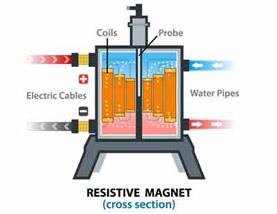
A magnet is any device that makes a magnetic field, which is really an interaction between electrons. There are quite a few types of magnets. There are permanent magnets and electromagnets. A permanent magnet will stick to a refrigerator; it is usually made of iron or other solid metals. Electromagnets are made of coils of wire and can be turned on and off, whereas a permanent magnet is not easily turned on and off.
Of the electromagnets there are a couple of types. There are superconducting and resistive magnets. A resistive magnet is one that's made out of a normal metal, that is copper or aluminum. The magnets that we build use what we call Florida Bitter magnet technology. They're copper sheet metal with lots of cooling holes stamped in them; there are also insulators with the same pattern. You can then stack those conductors and insulators to make a helical structure. You can put voltage across the coil and current will flow through it in a helix to make a high field in the center. The resistive magnets we make here at the National High Magnetic Field Laboratory are the highest-field DC magnets in the world.


